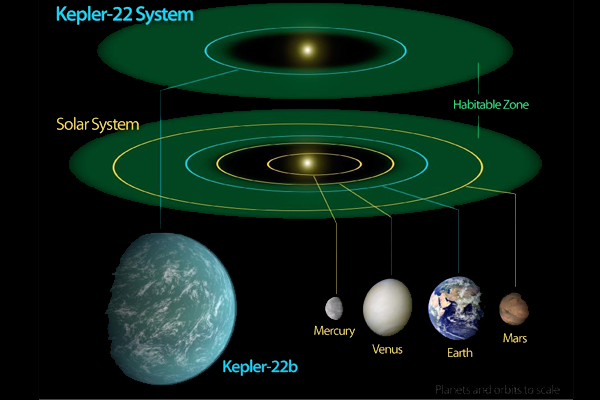An artist's conception of Kepler-22b
What’s the measure of life? Before you get all existential on us, we’re talking about the physical calculation for life to exist. Scientists have not yet found any sort of alien creatures on another planet, but they are pretty certain that such a planet would have to include water. After all, the best frame of reference is our own human lives. At least 60% of the body is water, and water is present in nearly every living object on this earth. Which makes the discovery of new planet Kepler-22b so thrilling.
NASA’s Kepler mission discovered the planet, simply named Kepler-22b, which lies in a “habitable zone” in a distant galaxy. NASA says it’s the first planet found, other than our own, that could sustain liquid water on its surface.
While located 600 light years away from Earth, Kepler-22b is perched an ideal distance away from its central star that could allow it to hold water. Indeed, many of the planet’s qualities are comparable to Earth’s, leaving scientists gleeful about its possibility of sustaining life. “This is a major milestone on the road to finding Earth’s twin,” Kepler scientist Douglas Hudgins said in a statement.
(LIST: 50 Space-Race Highs and Lows)
The potentially inhabitable planet has an orbit of 290 days around a sun-like star, which is very similar to our own, though slightly smaller and cooler. Kepler-22b itself is 2.4 times the radius of Earth, making it the smallest planet ever found in a star’s “habitable zone,” the sweet spot that allows an ideal temperature and climate for water to exist. However, scientists only know of Kepler-22b’s presence; they know nothing about its composition. But with this confirmation that it could sustain water – and perhaps even life – NASA will almost certainly continue to probe this far-off planet for more details.
The mission that discovered it is named Kepler, after 17th century stargazer Johannes Kepler, who published the laws of planetary motions. Kepler, NASA’s planet-hunting spacecraft, was launched in 2009 to scour the skies and report back to Earth its discoveries of new planets, searching for tiny dips in intergalactic brightness caused when a planet crosses in front of a star. The mission first detected Kepler-22b just three days after its launch in 2009 and monitored it, along with 54 others that it deemed to be in “habitable zones.” It’s the first out of the so-called “planet candidates” to be confirmed by ground-based telescopes and research.
PHOTOS: New Nebula Dazzles Astronomers

NASA / Ames / JPL-Caltech






